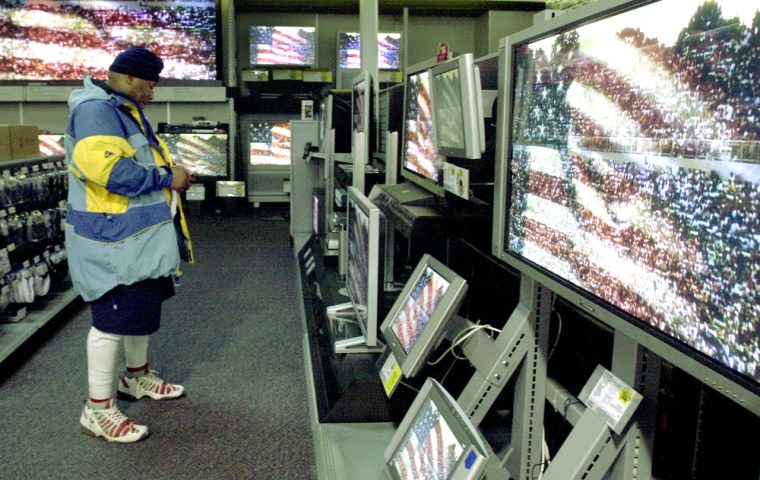Buying a television these days can be a bewildering and confusing experience for even the most savvy consumer.
A stunning array of technological advancements in recent years has made TV viewing far more pleasurable. At the same time, the choices are many, and the task of choosing the right television can become overwhelming quickly, especially for someone unfamiliar with how sets have changed.
It doesn't need to be, experts say. Keep a few simple points and tips in mind as you shop, and picking out the perfect set — whether spending $100 or $10,000 — still can be relatively straightforward and painless.
"If you haven't bought a television in 10 years, you're going to be very surprised at just how different they are today," said Steve Mullen, a spokesman for the retail electronics giant Circuit City. "Today, you go into a store and you can get a 42-inch plasma TV for $2,000 or up. And that's a good price compared to just a couple of years ago."
Lower prices
More efficient factories and improved manufacturing practices are contributing to price decreases for televisions, making them relatively more affordable than in the past. Highly advanced plasma TVs, for example, are expected to cost an average of $2,500 this year, almost half of last year's average price. If you're in the market for a new television and haven't been keeping up with technological advances, there are several things you need to know to get the best value for your money when you head to the nearest electronics store.
First, a prospective television buyer should become familiar with the four major types of sets on the market today:
CRT (cathode-ray tube) rear-projection sets have been around since the 1930s. They use cathode-ray tubes to beam colors onto a projection screen. They are relatively inexpensive, but the larger CRT sets are heavy and bulky. If you haven't bought a TV in years, this is probably what you have now. This is also known as SDTV, or standard definition television.
DLP (digital light processing) rear-projection sets use a single lamp that is replaceable when it wears out. They have a very clear picture and require no maintenance. But they are expensive, and the picture distorts when viewed at some angles.
LCD (liquid crystal display) rear-projection sets work by directing light through a silicone chip and magnifying it for display. These types of televisions are becoming more common and are popular because of their slim profile. But they are expensive.
Plasma (or flat panel) televisions are among the most sought-after because they combine a three-inch profile with a large screen. These technologically advanced sets work by illuminating thousands of lights to create images. Not all plasma sets are HDTV-capable, however, and the higher-end sets can cost $10,000 to $20,000. These are considered the best TVs money can buy.
HDTV
The foremost option to consider when buying a new television should be to get one capable of receiving digital programming, Mullen said.
"It's really the best way to watch television," he said. "It's becoming more widespread all the time."
Mel Espey, owner of Kincaid TV-Stereo on 15th Street, strongly encourages customers to purchase a set that is capable of HDTV.
"If they don't, they're taking a step backwards," he said. "HDTV is definitely the wave of the future."
Digital television and HDTV are not interchangeable terms, however, although some people confuse the two.
"High definition, by definition, is digital," Espey said. "But while all HDTVs are digital, not all digital televisions are HDTV."
Resolution
Another factor to consider is resolution. Standard CRT televisions rapidly flick an image back and forth across 480 lines that make up the screen, first firing the image onto half the lines and rapidly following up with a flash across the remaining lines. The effect is called interlaced scanning, and standard TV sets are said to have 480 interlaced — 480i — images.
Enhanced television sets, which fall between CRTs and HDTV, carry on with the 480 lines of resolution, but rather than alternately flashing the image onto first the even-numbered and then the odd-numbered lines, the sets fire across the lines one after the other. This is called progressive scanning, and it's done at twice the speed of interlaced. High-definition sets can have either interlaced or progressive scanning.
Plasma
By federal definition, HDTV units must have screens with either 720 lines of resolution progressively scanned — 720p — or 1080 lines with interlaced scanning — 1080i. Prices of modern TVs vary greatly, depending on the type of technology used and the size of the set. For example, a plasma television with a 42-inch screen capable of showing high-definition broadcasts can cost $3,000 or more.
Wide-screen, rear-projection 51-inch TVs can cost up to $2,000 or more, depending on the manufacturer.
Mullen said Circuit City stores stock a 50-inch plasma HDTV monitor with a price tag of about $6,000, while just down the aisle, a comparably equipped 50-inch HDTV monitor with DLP technology costs $3,300.
But you don't have to spend thousands on a plasma television to enjoy the future benefits of HDTV.
"Plasma televisions are about a lifestyle choice," Espey said.
Digital transition
The biggest impact on consumers right now is that many more televisions are equipped to handle digital broadcasting, even as broadcasters are lagging behind. Analog television, the standard broadcast technology that for decades has used magnetic waves to send pictures and sounds to a television, is quickly going the way of the dinosaurs. The FCC has mandated that digital broadcasting become the new standard for television.
The deadline for the end of analog broadcasting was set for the end of 2006 but keeps getting pushed back. The deadline is expected to be enforced before the end of the decade. There are only 17 HDTV cable networks out of 390 cable networks.
But that number will grow as the federally mandated conversion gains steam.
